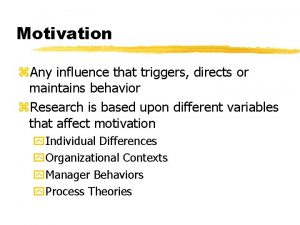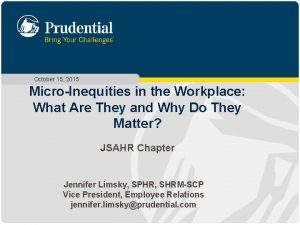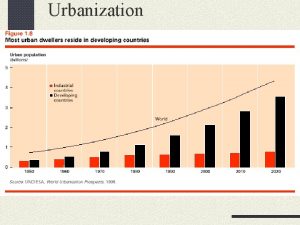Inequity and Inequality in a Healthy City Profile























- Slides: 23

Inequity and Inequality in a Healthy City Profile of Moscow Part I Irina Campbell, Ph. D, MPH ivm 1@columbia. edu www. Campbell. Health. Associates. com

Click for larger picture

As of August 1999, each region had its own internet site and established a presence on world wide web.

The socialist state has always recognized that part of its strength lay in the relationship between welfare provisions and a predictable, although basic and homogeneous, quality of life.

Changes in the health status of the Soviet population before Perestroika were shown by Schultz and Rafferty (1990) to undergo a marked deterioration: cardiovascular mortality rates increased by 50 percent since the 1960 s, comprising half of all Soviet deaths in 1980.

Soviet infant mortality increased to 27. 3 in 1980 from 24. 7 per 1000 live births in 1970. Infant deaths due to infectious diseases in the first year of life increased from 122 deaths per 100, 000 births in 1970 to 360 per 100, 000 births in 1980, and to 383 deaths in 1986; or about 66 percent over 16 years (Moscow Executive Committee, 1991).

The rate of chronic diseases in the FSU, including the number of cardiovascular deaths, suggested the pattern typical of industrialized societies (Ryan, 1990; Feshbach, 1982 b).

The developing and industrializing Asian Republics had the greatest incidence of water- and air-borne infectious diseases. Susceptibility to disease was increased by lack of vaccinations, crowding, poor sanitation, inadequate nutrition, and exhausting working conditions.

The longest life expectancy was found in Estonia, Latvia, Lithuania, Byelorussia, Ukraine, and Georgia, while the shortest was evident in Armenia, Turkestan, Kirgizia, Moldavia, Kazakhstan, and Russia (Goskomstat, 1988).

Two other major health problems, which became more acute during Perestroika (and after the explosion of the nuclear plant at Chernobyl in 1986), were alcoholism and the acknowledgement that one out of four cases of mental illness was due to mental retardation.

RUSSIA In Russia, health resources have become so depleted in the past decade that it is possible that Moscow has lost its ability to regain its previous international standing as a Great Power. Russia’s continued public health crisis is historically unprecedented.

Morbidity and mortality rates, however, did not increase uniformly in Russia but were concentrated in specific disease categories, geographic areas and among certain population groups such as working-age men.

Deaths from alcohol consumption and violence, including accidental poisoning, increased proportionately with the number of liters of pure alcohol consumed per capita and official alcohol sales, which however underestimate alcohol consumption in the population.

After decades of stagnation, and recent, crony capitalism, Russia’s health profile in the late 1990 s no longer resembled that of a developed country but was worse than many Third World countries. In 1997, overall life expectancy in Russia, under 67 years, was lower than Russia’s life expectancy forty years earlier.

In the post-Soviet decade, Russia suffered outbreaks of typhus, typhoid, and cholera; diphtheria is rampant, even in Moscow. Tuberculosis has more than doubled since 1990, and has been formally designated an epidemic by WHO.


The principal causes of death, cardiovascular and external causes, account for two-thirds of the Russian overall mortality rate.

Mortality from external causes is twice what is was during the Brezhnev and Gorbachev eras, and four times as great as the U. S. death rate attributed to injuries and poisonings.

Several other countries have a history of critical drops in life expectancy — Spain, in 1936 -39, Western Germany, in 1943 -46, Japan, in 1944 -45, and South Korea, in 1950 -53.

Russia’s health trends today also exemplify what has been termed "negative momentum". In Spain, Western Germany, Japan, and South Korea, health had been improving for several decades before their respective political crisis occurred. Rebounds in health status were rapid after the end of the crisis period.


Such projections, even if tentative, are significant indicators of future earning capacity and productivity in nations. Life expectancy is strongly associated with income and for Russia, it is a good predictor of productivity and per capita GNP.

At the end of Perestroika, the Russian Federation was the world’s fifth largest nation. In two decades, according to United Nation projections, Russia will drop to ninth place.
 Class inequity
Class inequity Underreward inequity
Underreward inequity Micro inequities in the workplace
Micro inequities in the workplace Lesson 1-6 solving compound and absolute value inequalities
Lesson 1-6 solving compound and absolute value inequalities Healthy food healthy mind journal
Healthy food healthy mind journal Healthy soil healthy life poster ideas
Healthy soil healthy life poster ideas Healthy forests healthy communities poster ideas
Healthy forests healthy communities poster ideas Healthy nurse healthy nation
Healthy nurse healthy nation Latin american city models
Latin american city models Cbd inner city suburbs
Cbd inner city suburbs Primate cities
Primate cities Compound inequality symbols
Compound inequality symbols Comparisons of equality ejemplos
Comparisons of equality ejemplos Comparative of equality and inequality
Comparative of equality and inequality Comparisons of equality ejemplos
Comparisons of equality ejemplos Addition and subtraction property of inequality
Addition and subtraction property of inequality Compound inequalities examples
Compound inequalities examples Comparative equality ejemplos
Comparative equality ejemplos Inequality and graph
Inequality and graph At least inequality sign
At least inequality sign What is the difference between and and or inequalities
What is the difference between and and or inequalities Stratification and inequality
Stratification and inequality Inequality and poverty
Inequality and poverty Cumulative probability distribution
Cumulative probability distribution













































